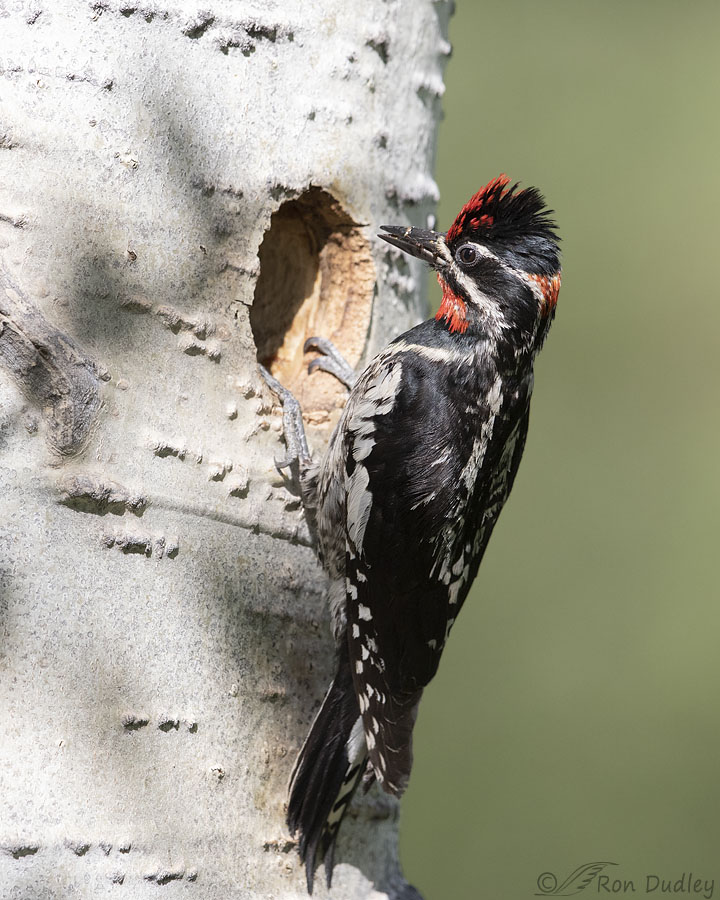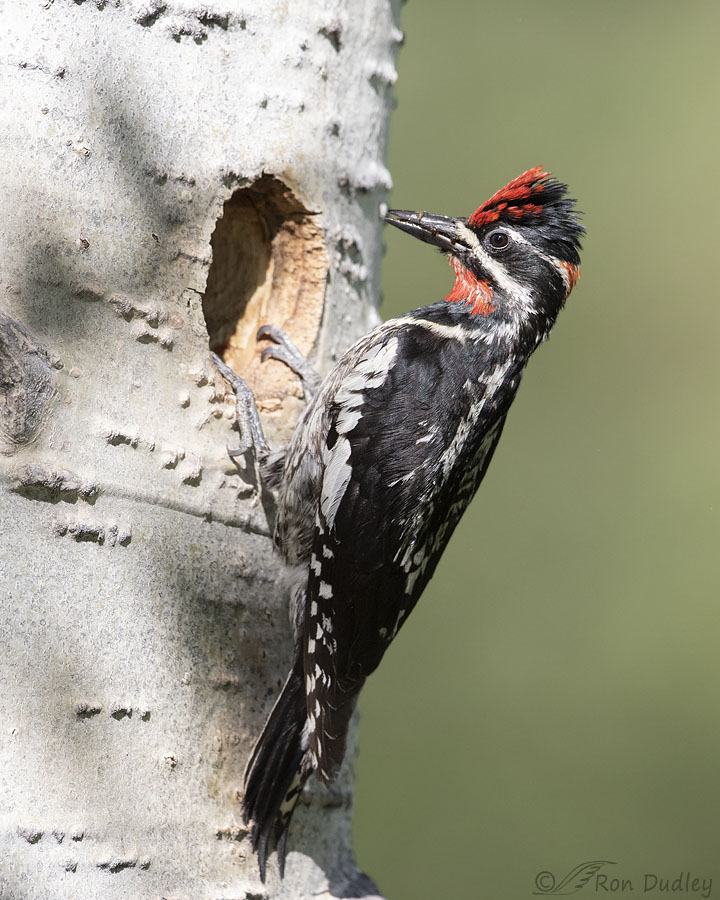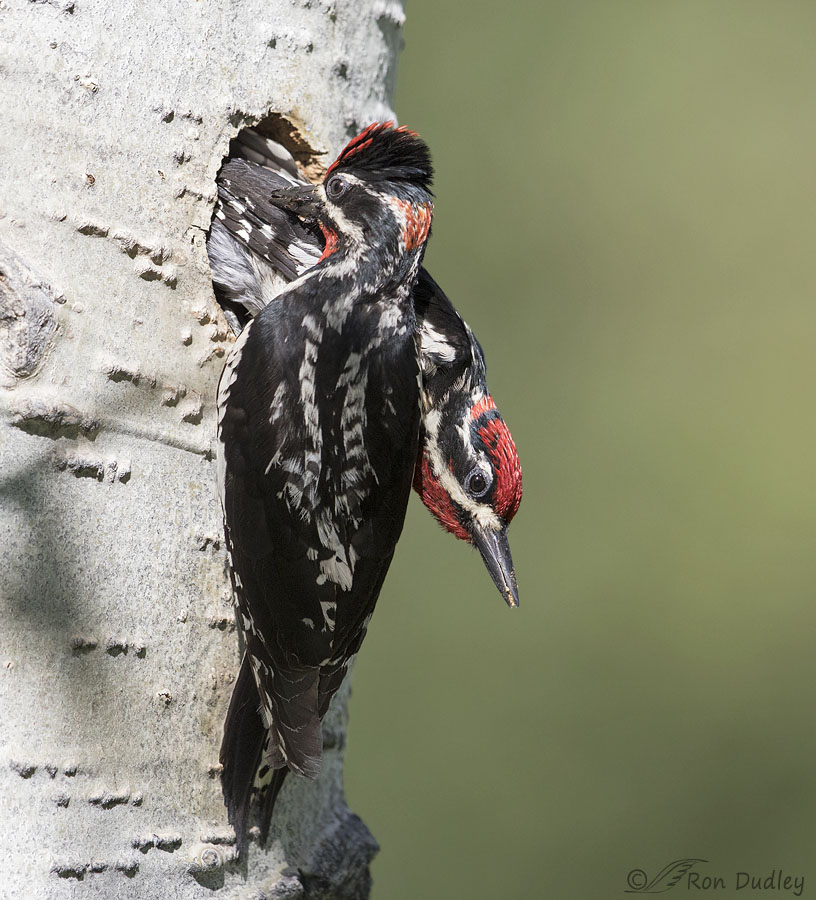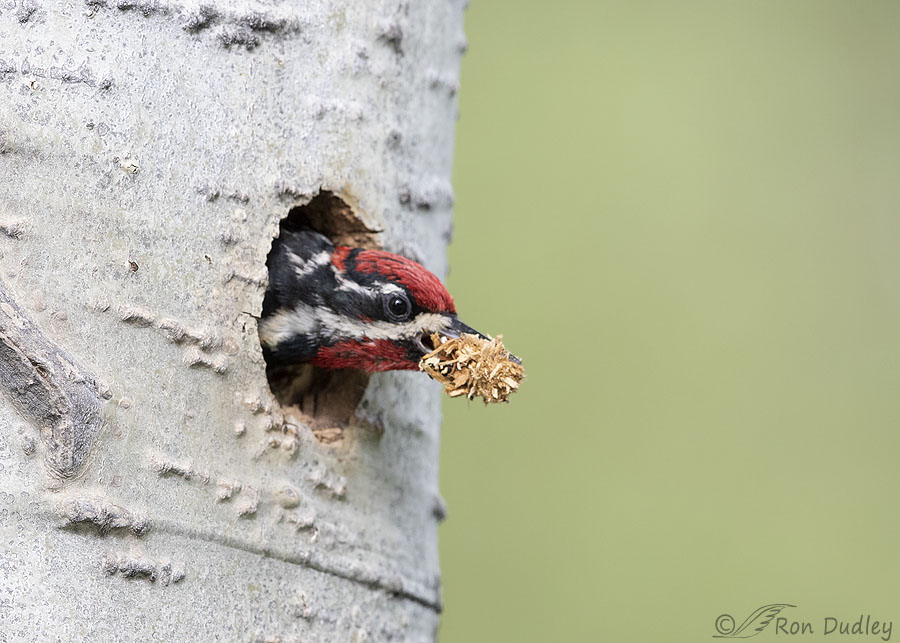Hungry chicks in the nest cavity have to be fed and it’s a two parent job.
I posted one of these photos several years ago but the other three are new to my blog.

1/2500, f/5, ISO 800, Canon 7D Mark II, Canon EF 500mm f/4L IS II USM, not baited, set up or called in
Four years ago today I was photographing nesting Red-naped Sapsuckers in the Uinta Mountains. Both adults were busy feeding sap-dipped ants to their chicks and removing fecal sacs and wood chips from the nest cavity.
I believe this is the female of the pair about to enter the cavity with a load of ants. I took many shots of her before she entered the cavity but I like these two in particular because her red crown was raised which was something I didn’t often see.

1/2500, f/5, ISO 800, Canon 7D Mark II, Canon EF 500mm f/4L IS II USM, not baited, set up or called in
For a moment she pulled her head back and turned it my way slightly which allowed an even better look at her raised red crown. It’s too bad that her head position put a shiny spot on the aspen bark right at the tip of her bill.
She didn’t enter the nest cavity immediately because her mate was already inside collecting wood chips for disposal. I was always trying to capture them leaving the nest but it’s an explosive exit and easy to miss.
This time I missed it.

1/3200, f/5, ISO 640, Canon 7D Mark II, Canon EF 500mm f/4L IS II USM, not baited, set up or called in
But seven minutes later I had better luck. Here the exiting bird has a small load of wood chips that can be seen inside its bill.

But the wood chip loads weren’t always small. Sometimes I marveled that they could stuff so many chips into their bills and make them stay there.
Chips are removed from the cavity for two reasons – they’re often sodden with chick wastes so they have to be removed for sanitary reasons and the adults are constantly chipping away at the interior of the cavity to make it large enough to accommodate the growing chicks. When I’m photographing sapsuckers at their nest cavity I can often hear them pounding away inside where I can’t see them. When I hear the pounding stop I know it’s time to get ready with my camera for one of their explosive exits.
To be successful at catching them leaving the cavity photographers have to use every trick in the book (as long as it’s ethical and safe for the birds of course.)
Ron


Ron, thanks for the great shots and education to go along with them. It is amazing how these Sapsuckers [and other birds] raise a family, feed them, clean out their nest, etc. Birds are smart, aren’t they?
Wonderful!
Thanks, Jane.
Wow! Wonderful. I’ve never seen one of these woodpeckers, but would certainly like to. To capture these moments you must be very alert and agile. Not sure I could have ever done it.
“you must be very alert and agile”
Well that brought a big smile, Nancy. An ironic smile. I like to think I’m alert but I’m far from agile. I wish you saying it could make it so.. 🙂
Kudos for the outstanding photos. Great post and comments. Amazing to see such a perfectly formed nest entrance.
Thanks, Lyle. I often think that if I could get there at the right time in the spring I could catch them using a compass to lay out those almost perfect circles.
Now that would be a photo to remember.
Again, you have fascinated, intrigued, and educated me — the trifecta of a great day!
Amazing how they can stuff that many wood chips in their beaks. Sort of reminds me of our contests at camp, stuffing Saltines or marshmallows in our mouths and then trying to say the name of the camp. Yes, young musicians are an odd bunch.
“Yes, young musicians are an odd bunch”
That’s been my experience with them too, Marty… 🙂
Thank you and your knowledgeable commentators. Eye candy teamed with learning are an excellent start to my day.
Thanks, EC.
These are beautiful. I was watching one and trying to photograph it the other day. It was deep in the willows along the shores of a lake. It was making sap wells in the willow and collecting the sap from older holes. My camera focus kept pulling to willow branches in the foreground.Never the less, it was interesting to watch!
Thanks, April. Making sap wells in willows – I don’t remember ever seeing their wells in willows.
I appreciate the “continuing ed”, too ( re–expanding the interior size of the
nest cavity ). Any idea why the ant meals get dipped into sap ? To hold
them together ? Because they’re naturally found in sap,? To train the chicks
for the association ?
“Any idea why the ant meals get dipped into sap ?”
Kris, as adults this species eats sap almost exclusively – they’re called sapsuckers for good reason. I suspect dipping the ants in sap at their sap wells before feeding them to their chicks conditions their digestive system to an eventual diet of sap.
Ants and other arthropods are often trapped in tree sap and are taken incidentally when feeding on sap. But insects are actively sought after throughout life because insects provide the necessary source of protein that is lacking in just sap. Like hummingbirds, sapsuckers cannot survive on a diet exclusively of sugar. Insects are essential, but are consumed in less quantity than in most other woodpeckers. When young are present in the nest, insects are the primary food that is provided to them. Many of those insects are found at sap wells and are often trapped there so the adults provide sap-coated insects to the young. As the young are closer to fledging, more sap is added to the diet.
Thanks you, Dan. Great info.
Huge thanks Dan.
Would the sap also increase the calorie content of the food?
The female’s crest in the first 2 photos looks a but unnatural – almost like a trip to the beauty parlor to tip the feathers red.
“Would the sap also increase the calorie content of the food?”
Pam, since tree sap consists primarily of sugars, hormones, and mineral elements dissolved in water I would have to – especially from the sugars.
Ants taste si much better dipped in honey, sap or Bar-B- Q sauce! Try’em. You’ll like them…😇
Nope, don’t think so, Patty…
VBG! They REALLY do “shoot out of there”! It is amazing how many chips they can get in their beak and make them stay……. I had no idea they expanded the cavity as the chicks grew – “continuing education”.. 🙂
Cooler today – perhaps a break from the snakes – buzztail #4 yesterday….wonder what July and August will be like? Suspect with our mild winter they wintered well……. 😉
Judy, the adults are expanding the cavity so much of the time I can usually tell if they’re inside just by the pounding sound. Another helpful tidbit for the photographer.
Reminded me of one of my all-time top movies, The Great Escape. What great shots getting both those exploding out of the cavity and especially the one with that load of chips. And neat to see the raised crown. I have only see these Sapsuckers twice and neither time did it have the raised crown. These out of a cavity exploding shots are so hard. The Western Bluebirds stick their head out first to look around and then shoot out and even then I sometimes miss the shot.
“even then I sometimes miss the shot”
If you only miss it ‘sometimes’ I’d say you’re doing very well, Everett.
I miss having Steve McQueen around.
Great shots!
Thanks, Jean.